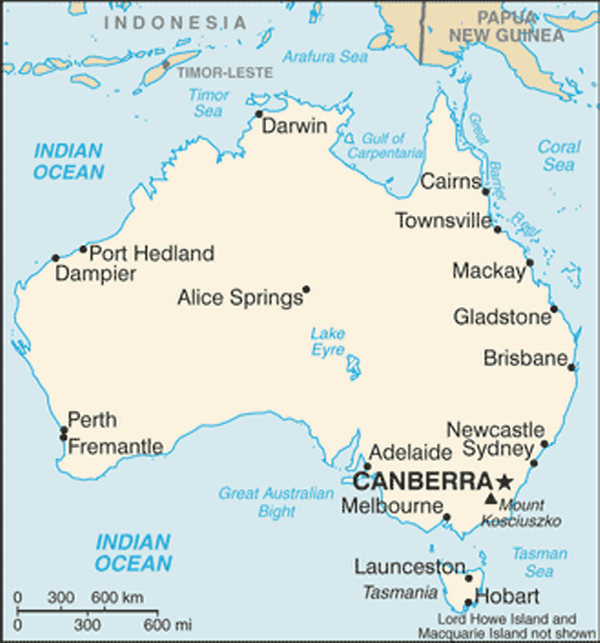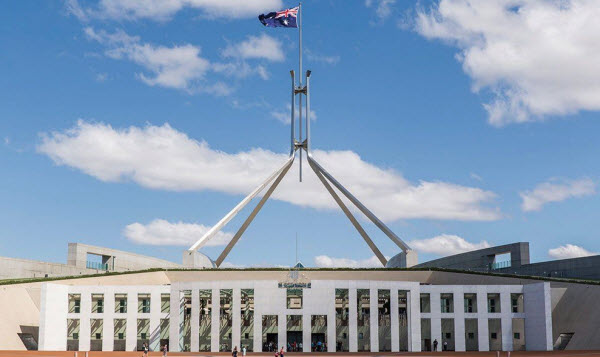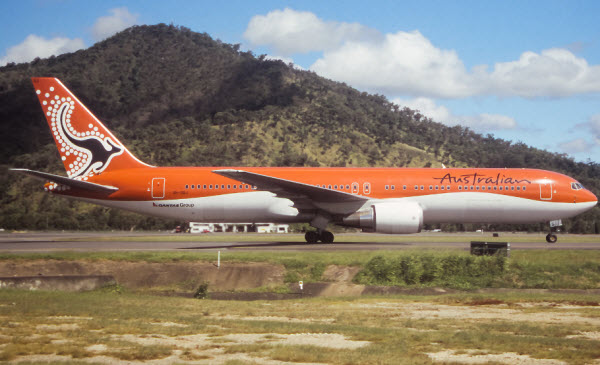Australia, officially known as the Commonwealth of Australia, is a country and continent located in the Southern Hemisphere. It is known for its diverse landscapes, unique wildlife, and vibrant cities. Australia is a developed country with a high standard of living and a strong economy.
Geography

- Location: Southern Hemisphere, bordered by the Indian Ocean to the west and the Pacific Ocean to the east. It is situated south of Asia.
- Coordinates: Approximately 25.2744° S, 133.7751° E.
- Area: Approximately 7,692,024 square kilometers.
- Borders:
- Australia does not share land borders with any other country.
- Climate:
- The climate varies from tropical in the north to temperate in the south. The country experiences four distinct seasons: summer, autumn, winter, and spring.
- Terrain:
- The terrain includes coastal plains, mountain ranges (such as the Great Dividing Range), deserts (like the Outback), and tropical rainforests.
- Elevation:
- The lowest point is Lake Eyre (-15 m), and the highest point is Mount Kosciuszko (2,228 m).
- Natural Resources:
- Includes coal, iron ore, gold, natural gas, and bauxite. Australia is also known for its rich agricultural resources.
- Land Use:
- Arable land: approximately 6%, permanent crops: 0.6%, other: 93.4%.
- Population Distribution:
- Most of the population is concentrated along the eastern and southeastern coasts in major cities such as Sydney, Melbourne, and Brisbane.
Population and Society

- Population: Approximately 26 million (estimate for 2024).
- Ethnic Groups:
- Predominantly of European descent, with significant populations of Asian and Indigenous Australian backgrounds.
- Languages:
- The official language is English.
- Religions:
- Major religions include Christianity, with significant communities of Buddhism, Islam, and Hinduism.
- Age Structure:
- Australia has an aging population with a significant proportion over 65 years and a growing working-age population.
- Population Growth Rate:
- Approximately 1.2% per year.
Country

- Country Name: Commonwealth of Australia
- Common Name: Australia
- Origin of Name: The name “Australia” is derived from the Latin word “australis,” meaning southern, reflecting its position in the Southern Hemisphere.
- Type of Government: Federal parliamentary constitutional monarchy.
- Capital: Canberra
- Origin of Capital Name: Canberra was chosen as the capital in 1908 as a compromise between rivals Sydney and Melbourne. The name is derived from the local Aboriginal word “Canberry.”
- Local Time: Australian Eastern Standard Time (AEST) (UTC+10:00) with variations for other time zones.
- Daylight Saving Time: Observed in some states.
- Administrative Divisions: 6 states and 2 territories.
- Dependent Areas: Includes external territories such as Christmas Island and the Cocos (Keeling) Islands.
- Independence: Became a federated state within the British Empire on January 1, 1901; gained full sovereignty with the Statute of Westminster in 1931 and the Australia Act in 1986.
- Citizenship Acquisition: By birth, descent, or naturalization.
- Legal System: Common law system based on English law with adaptations for Australian conditions.
- Executive Branch: The Governor-General represents the monarch, while the Prime Minister is the head of government.
- Legislative Branch: Bicameral Parliament consisting of the House of Representatives and the Senate.
- Judicial Branch: The High Court of Australia is the highest court.
- Political Parties: Includes major parties such as the Liberal Party, the Australian Labor Party (ALP), and the Greens.
- Flag Description: A blue field with the Union Jack in the canton and a large white seven-pointed star (Commonwealth Star) and the Southern Cross constellation.
- Country Code: AUS
Economy
- GDP: Approximately 1.5 trillion USD.
- Agricultural and Animal Products: Wheat, barley, cattle, sheep, and wool.
- Industries: Mining, agriculture, manufacturing, and services.
- Budget: Australia has a significant budget with an emphasis on social services, health, and infrastructure.
- Exports: Iron ore, coal, natural gas, and gold.
- Imports: Machinery, vehicles, petroleum products, and chemicals.
- Foreign Reserves: Approximately 70 billion USD.
- External Debt: Approximately 1 trillion USD.
- Local Currency: Australian Dollar (AUD).
Communications
- Fixed Lines: Approximately 10 million lines.
- Mobile Lines: Approximately 25 million lines.
- Country Code: +61
- Broadcast Media: Australian Broadcasting Corporation (ABC), commercial TV channels, and numerous radio stations.
- Internet Code: .au
- Internet Users: Approximately 22 million people.
Transport

- National Air Transport System: Extensive network with major international and domestic airports.
- Airports: More than 500 airports.
- Heliports: Limited number, mainly in major cities.
- Pipelines: Includes pipelines for oil and gas.
- Railways: Extensive network with services for both passengers and freight.
- Road Network: Includes national highways and state roads totaling over 800,000 kilometers.
- Ports: Major ports include Sydney, Melbourne, Brisbane, and Fremantle.
Military

- Military Composition: Includes the Australian Defence Force (ADF), which comprises the Army, Navy, and Air Force.
- Military Expenditures: Approximately 40 billion USD per year.
- Personnel in Military and Security Services: Approximately 80,000 active members.
- Military Equipment: Includes advanced fighter jets, naval ships, submarines, and armoured vehicles.
- Military Service Age: Voluntary enlistment with no mandatory service requirement.
